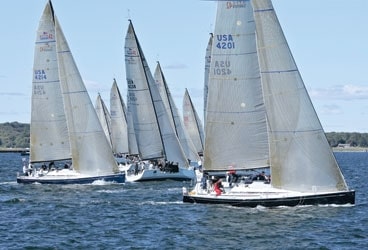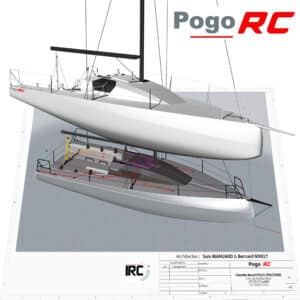
ClubSwan42
Like any sailboat, the Club Swan 42 comes with it’s own set of numbers: sail area, draft, displacement, price, etc. But the one that matters most has nothing to do with the design of the boat. That number is 30, which is the total boats sold before hull No. 1 was christened this fall at the New York YC. I can’t think of another big boat in recent memory that generated this much interest before anyone was able to actually see it in person.For those of you unfamiliar with this 42-footer, let me back up a bit. In the spring of 2005, the NYYC announced it wanted to create a one-design racer/cruiser, 42 to 44 feet in length. As precocious as this sounds, it’s actually something the club had done eight previous times since 1900, when Nat Herreshoff designed the NY70. The boat needed to rate well under IRC and be suitable for both inshore buoy racing and offshore events. Three designers submitted their thoughts on how this boat should look: Mark Mills, Farr Yacht Design, and German Frers/Nautor’s Swan. The Frers/Swan partnership won the contract.Before the first boat was delivered stateside, 24 had been sold to NYYC members based from Annapolis, Md., to Boston. Sales were subsequently opened to the general public and another six boats were snapped up. It’s expected to take about a year to deliver the 24 sold to NYYC members, according to Kevin Dailey of Nautor’s Swan, but that should still put enough of the boats in Newport next summer to make the class’s inaugural national championships an impressive regatta. With that kind of early momentum, it’s hard to imagine this design not meeting expectations. When it comes to building a successful one-design class, having a really great boat is nice, but a strong, active group of committed owners is much better.The first boat, owned by a quartet including Rear Commodore David Elwell, the driving force behind the project, Commodore George Hinman, Richard Werdiger, and Donald Elliman, was christened in early October.While the rest of my colleagues were at the U.S. Sailboat Show in Annapolis, Md., awash in the latest sailing technology and some heavy fall rains, I enjoyed a short sail on the Club Swan 42 on a perfect New England October day. As it was a short sail-the boat had a date with a bottle of champagne around 11 a.m.-it wasn’t enough to really give the boat a thorough review. But what I saw of the 42-footer I liked. The deck and cockpit will make it easy for a crew to push the boat hard around the buoys. At the same time the boat has a very “clean” look, with the halyards and double-ended mainsheet led under the deck. The twin wheels really open up the cockpit and give the helmsman a great sightline to the jib telltales. Dual hydraulic panels enable the main trimmer to easily adjust the backstay and outhaul whenever he pleases.Belowdecks, the Club Swan 42 is functional, but not spartan. Anyone planning some serious offshore racing will do better with the single-head layout, which has two double berths aft, and allows for at least three sea berths on either side.Upwind, the boat sailed easily at between 7.5 and 8 knots in a gusty 8- to 18-knot northerly. In flat water, it tracked beautifully, with just enough windward helm on the wheel. In the gusts, just a small flick of the wheel to leeward kept the boat charging in a straight line. Maintaining control was not an issue. As we turned downwind, the boatspeed shot up to near 10 knots on a reach. We were unable to see what it could do with the spinnaker flying as the one we had on board was in two pieces for some strange reason. However, downwind performance should be excellent. The polars predict speeds upwards of 15 knots in heavy breeze.At that speed, this boat will be a handful for the Corinthian crews stipulated by the class rules. While two Cat 3 sailors are allowed to sail on the boat, neither can be paid to race. It’s assumed that one will be the boat captain, the second perhaps a sailmaker or other industry professional. This rule is designed to all but eliminate the presence of professional tacticians, trimmers, and bowmen in class racing. The sprit will reduce the complexity of the maneuvers. However, the asymmetric spinnaker is huge. At 1,991 sq. ft., it’s approximately 15 percent larger than the new masthead Farr 40 kite, and 21 percent larger than the Swan 45 spinnaker. It will demand precise timing and a fair amount of athleticism to keep it out of the drink on douses or from wrapping around itself on jibes. Tuning the rig and changing gears will also be a challenge.However, it’s a challenge that amateur sailors will be eager up to take, especially with 20 other crews against which to test their respective skills. With so many boats already sold, reviewing the Club Swan 42 was almost a case of looking for a reason why it wouldn’t succeed. I didn’t find any.









